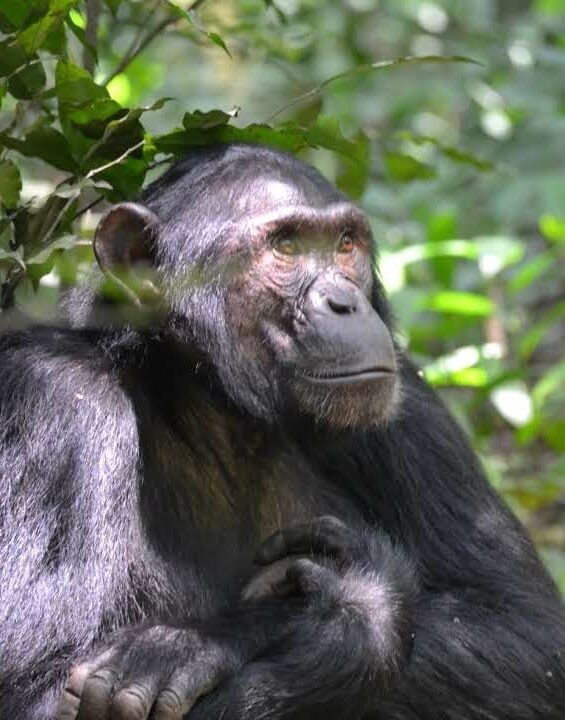What Is The Difference Between Gorilla And Chimpanzee Trekking In Uganda?

What Can I Do On Safari In Queen Elizabeth National Park Uganda
August 9, 2023
What can possibly go wrong on gorilla safari in Uganda or Rwanda
August 18, 2023Gorilla trekking is an adventure where a maximum of 8 tourists search for a fully habituated mountain gorilla family and stay with them for one hour. Chimpanzee trekking on the other hand is an adventure where maximum 6 tourists are allowed to follow a chimpanzee troop and stay with it for one hour per session.
In Uganda, gorilla trekking only happened in two national parks that Bwindi Impenetrable national park and Mgahinga National Park. A number of natural habitats are homes to chimpanzees in Uganda and sanctuaries too.
Kibale National Park is the largest chimpanzee trekking habitat hosting over 1500 chimpanzees and over 15 fully habituated chimpanzee communities. Kaniyo Pabidi forest in Murchison Falls National Park, Kyambura Gorge in Queen Elizabeth National Park, Kalinzu Forest Reserve, Semuliki National Park and others arehomes for the chimpanzees. Ngamba chimpanzee Sanctuary Island in Lake Victoria and Uganda wildlife Education center in Entebbe are homes to rescued chimpanzees too.
Uganda hosts some of the largest African primate population especially the endangered mountain gorillas that number to about 1000 per the recent census.
For one to do either gorilla trekking or chimpanzee trekking, obtaining a gorilla permit is necessary to be allowed access to this primate safari. Since there is a limit to the number of people allowed to do gorilla or chimpanzee trekking, you need advance permit booking.

Brief Physical Differences Between the mountain gorillas and chimpanzees
Physically mountain gorillas have dark hairy bodies from head to toe and huge in size where an average fully grown male weights about 200 kilograms or 450 lb. Mountain gorillas are naturally vegetarian with bamboo as there favorite. They can only exist in the mountains and in an environment just where they currently live. This may explain the reason why they are not found in the other parts of the world but only in the Virunga area.
Chimpanzees are physically smaller than mountain gorillas with a more clearer face similar to humans. This may be one of the reasons why they are human’s closest relatives as they posses about 98% human DNA. Chimpanzees feed on foliage however during the severe dry seasons, they may chip in some wild meat of the monkeys.
How different is Gorilla Trekking From Chimpanzee Trekking In Uganda?
By taking a primate Uganda safari including gorilla trekking and chimpanzee trekking, you get the practical reality between mountain gorillas and chimpanzees. Some of the differences between gorilla trekking and chimpanzee trekking include
Cost of permits
The current cost of Uganda gorilla trekking permit is $700 per person per trek for foreign nonresidents, $600 for foreign residents and 250000shs for East African residents.
The chimpanzee trekking permit cost for Uganda varies with location but in Kibale National Park, the chimpanzee permit costs $200 per person per trek for foreign nonresidents, $150 per person per trek for foreign residents and 150000shs for East African residents.
Primate Safari destinations
For gorilla trekking, this takes place in only two parks that is Mgahinga National Park and Bwindi Impenetrable National Park. Chimpanzee trekking happens in various destinations that is Kibale National Park, Kyambura gorge, Kaniyo Pabidi forest, Kalinzu forest reserve and many others.
Number of sessions when doing gorilla or chimpanzee trekking
Chimpanzee trekking has two sessions that is morning and afternoon in Uganda while gorilla trekking happens once in a day. This is for conservation reasons as mountain gorillas entirely feed on foliage and so have to feed on enough to support there huge bodies day and night.
Age limit for either gorilla or chimpanzee trekking
The age limit for gorilla trekking is 15 years and beyond because of the nature of the topography and vegetation of this area which is Volcanic with its scars. Children below 15 years my not be in position to withstand hiking to find the mountain gorillas on the slopes or deep in the valleys.
Chimpanzee trekking age limit is beyond 12 years because every trekker is required to walk into the forest to find the chimpanzees. Even the sometimes teasing nature of the chimpanzees may not be easy to be withstood by a child below the minimum age.
Number of Tourists allowed to do gorilla or chimpanzee trekking
Maximum 8 tourists are allowed to do gorilla trekking per day per family to minimize impacts of mass tourism to nature from which mountain gorillas obtain food.
The maximum number of tourists allowed to do chimpanzee trekking per session is 6 per troop. Two sessions take place each day during chimpanzee trekking that is morning and afternoon.
When is the best time to book chimpanzee or gorilla trekking permit
Booking your gorilla or chimpanzee permit at least 6 months to a year in advance is the best decision especially if you hope to travel for the primate safari in Uganda during the high season. The high tourism season in Uganda normally runs June, July, August, September, December and January. The gorilla or chimpanzee permits for this season run low before 3 months to starting of season.
Although last minute gorilla or chimpanzee trekking permits may be available during the low season that runs March, April, May and November, its not a guarantee. Before travelling to attend gorilla or chimpanzee trekking in the low season, you need to check prevailing availability upfront. You need to secure your trekking permit too because status of the gorilla or chimpanzee permits changes any time.
Note:
No gorilla permit is reserved without payment and yet first come first served basis is used to secure the gorilla permits.
Can I Purchase the Uganda gorilla or chimpanzee trekking permits in Instalments?
Securing your gorilla or chimpanzee trekking permit with full payment is the approach however instalment purchase is accepted too. Conditions for gorilla or chimpanzee permit instalment purchase include: you must purchase the gorilla or chimpanzee permit before 90 days to trekking date.
Remember to make full payment before 90 days to trekking date.
Failure to comply by the Uganda wildlife authority gorilla permit instalment purchase policy may yield a penalty.
What Is The Cost Of Gorilla And Chimpanzee Trekking Safari?
The gorilla and chimpanzee trekking safaris vary with package category you select that is to say luxury, mid-range or budget. The accommodation facilities you choose plays a lot in determining the primate safari category.
The universal chimpanzee or gorilla safari cost is the permit which cuts across all categories.
To get the gorilla or chimpanzee safari cost, you need to include the cost of additional activities to combine with the primates safari. Even the number of people traveling with for gorilla or chimpanzee trekking, number of days on primate safari and several others.
How sure can I be to locate the chimpanzee or mountain gorillas in Uganda?
There are 98% chances of finding the mountain gorillas or chimpanzees during gorilla trekking or chimpanzee trekking safari. Before being opened to public viewing, wild mountain or chimpanzees are habituated to human presence for some unknown period.
Gorilla or chimpanzee habituation is a process where a team of researcher and habituators follows a wild gorilla family or chimpanzee community to get them used to human presence without altering there nature.
A fully habituated gorilla family or chimpanzee troop cannot abandon its visitors unless some rules of gorilla or chimpanzee trekking are violated. This is why attending briefing before any trek is key to avoid causing a stampede in the forest.
Each day a team of trackers wakes earlier than tourists to establish where the mountain gorillas or chimpanzees may have spent the night or possible hangout spot for the day. The rangers escorting tourists use the clues provided by earlier trackers so as not to let tourists wonder in the forest.
Upon locating the mountain gorillas or chimpanzees only one hour is allowed before them for conservation reasons.

When Is The best Time To Book Gorilla and Chimpanzee Trekking Safari in Uganda?
Gorilla and chimpanzee trekking experience is open all year however, you need to book the permits for each of these activities in advance. The peak season is the busiest yet the gorilla or chimpanzee trekking permits are sold out in advance. The high tourism season of Uganda and Rwanda runs June, July, August, September, December and January.
Its best to secure the gorilla or chimpanzee permits in advance atleast 6 months to a year upfront in order to prevent last minute hassle of trying to find or availability. in case you really wish to see the mountain gorillas, you can risk waiting for a gorilla or chimpanzee permit resell or a no-show but this is a risky approach.
Last minute gorilla or chimpanzee permits may be available in the low season that runs March, April, May and November. During this time, demand for gorilla and chimpanzee permits is less than usual however do not risk travelling for this primate adventure without enquiring about availability.
How Difficult Is Gorilla trekking or chimpanzee trekking?
Both gorilla and chimpanzee trekking are quite strenuous but most especially gorilla trekking. These adventures happen in the wilderness where there are thick trees and tangled vegetation that has accumulated over time.
The nature of the topography of the Virunga area is volcanic and a number of highlands over which vegetation drapes make up the largest part of the park. Although the chimpanzee trekking tropical forests have less undergrowth, the trees are huge with protruding buttress roots. Having some level of fitness protects you from getting tired before completing either gorilla or chimpanzee trekking.
Is gorilla or chimpanzee safari safe?
Even though these primate adventures happen in the wilderness, the mountain gorillas and chimpanzees are first habituated to human presence. The habituation process takes some unknown time until the mountain gorillas or chimpanzees get accustomed to presence of new faces.
In nature the mountain gorillas or chimpanzees that are habituated can bare to stand before humans for a stipulated time that is only one hour for gorilla or chimpanzee trekking. Four hours of mountain gorilla or chimpanzee habituation experience.
The escorting ranger guides of each tourist group carry a machete and rifle just in case you need urgent defense. They carry a radio call to keep in constant communication with the guides at the ranger station in case back up is needed. The ranger guide follows the pace of the slowest trekker so that no body is forgotten in the wilderness.
Tourists need to mind personal safety by not entering the forest without an escorting ranger guide. Do not sneak away during gorilla or chimpanzee safari so that you are not forgotten in the vast forest.
What Is The Age Limit For Gorilla Or Chimpanzee Safari?
The gorilla safari age limit is 15 years and above while chimpanzee trekking age limit is above 12 years. These limits were set because of the nature of these activities as children below these ages may not with stand forest conditions.
Both gorilla and chimpanzee safaris have guidelines, which have to be followed religiously, however, children below the age limits may not abide by the rules. Violating the gorilla or chimpanzee safari rules may agitate the mountain gorillas causing a stampede.
What are the guidelines of gorilla or chimpanzee safari?
Feeding the gorilla and chimpanzees is forbidden as these are wild animals that must seek there own meal and not human dependence.
Leave a gap of about 8 meters from the mountain gorillas or chimpanzees when you locate them. This is to prevent chances of passing an infection to these primates.
Avoid littering the forest as this alters the nature of the habitat where mountain gorillas and chimpanzees thrive.
Keep close to the people you are trekking the chimpanzees with and do not surround the mountain gorillas. This is because you may agitate the mountain gorillas or chimpanzees causing them to dash into hiding.
In case you want to smoke or eat, do it away from the mountain gorillas or chimpanzees so as not to entice them to grab it from you.
Spitting on vegetation or the ground may pass an infection to the highly susceptible mountain gorillas or chimpanzees. These endangered primates depend on foliage to survive which you may contaminate.
Viewership of fully the habituated mountain gorillas and chimpanzees is restricted to one hour. For chimpanzee or gorilla habituation experience, four hours are allowed.





